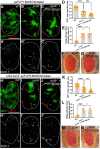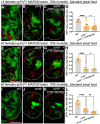PTP10D-mediated cell competition is not obligately required for elimination of polarity-deficient clones
- PMID: 36355597
- PMCID: PMC9672856
- DOI: 10.1242/bio.059525
PTP10D-mediated cell competition is not obligately required for elimination of polarity-deficient clones
Abstract
Animal organs maintain tissue integrity and ensure removal of aberrant cells through several types of surveillance mechanisms. One prominent example is the elimination of polarity-deficient mutant cells within developing Drosophila imaginal discs. This has been proposed to require heterotypic cell competition dependent on the receptor tyrosine phosphatase PTP10D within the mutant cells. We report here experiments to test this requirement in various contexts and find that PTP10D is not obligately required for the removal of scribble (scrib) mutant and similar polarity-deficient cells. Our experiments used identical stocks with which another group can detect the PTP10D requirement, and our results do not vary under several husbandry conditions including high and low protein food diets. Although we are unable to identify the source of the discrepant results, we suggest that the role of PTP10D in polarity-deficient cell elimination may not be absolute.
Keywords: Drosophila; Cell competition; Dlg; Epithelial polarity; PTP10D; Scrib.
© 2022. Published by The Company of Biologists Ltd.
Conflict of interest statement
Competing interests The authors declare no competing or financial interests.
Figures





Similar articles
-
The ligand Sas and its receptor PTP10D drive tumour-suppressive cell competition.Nature. 2017 Feb 9;542(7640):246-250. doi: 10.1038/nature21033. Epub 2017 Jan 16. Nature. 2017. PMID: 28092921
-
Serpin Facilitates Tumor-Suppressive Cell Competition by Blocking Toll-Mediated Yki Activation in Drosophila.Curr Biol. 2018 Jun 4;28(11):1756-1767.e6. doi: 10.1016/j.cub.2018.04.022. Epub 2018 May 24. Curr Biol. 2018. PMID: 29804808
-
Minimal functional domains of the core polarity regulator Dlg.Biol Open. 2022 Jul 15;11(7):bio059408. doi: 10.1242/bio.059408. Epub 2022 Jul 25. Biol Open. 2022. PMID: 35722710 Free PMC article.
-
Drosophila Models of Cell Polarity and Cell Competition in Tumourigenesis.Adv Exp Med Biol. 2019;1167:37-64. doi: 10.1007/978-3-030-23629-8_3. Adv Exp Med Biol. 2019. PMID: 31520348 Review.
-
Elimination of oncogenic cells that regulate epithelial homeostasis in Drosophila.Dev Growth Differ. 2019 Jun;61(5):337-342. doi: 10.1111/dgd.12604. Epub 2019 Apr 7. Dev Growth Differ. 2019. PMID: 30957223 Free PMC article. Review.
Cited by
-
The cell-adhesion molecule Echinoid promotes tissue survival and separately restricts tissue overgrowth.Development. 2025 Aug 1;152(15):dev204572. doi: 10.1242/dev.204572. Epub 2025 Aug 7. Development. 2025. PMID: 40689564 Free PMC article.
References
-
- Andersen, D. S., Colombani, J., Palmerini, V., Chakrabandhu, K., Boone, E., Röthlisberger, M., Toggweiler, J., Basler, K., Mapelli, M., Hueber, A.-O. >et al. (2015). The Drosophila TNF receptor Grindelwald couples loss of cell polarity and neoplastic growth. Nature 522, 482-486. 10.1038/nature14298 - DOI - PubMed
Publication types
MeSH terms
Substances
Grants and funding
LinkOut - more resources
Full Text Sources
Molecular Biology Databases

